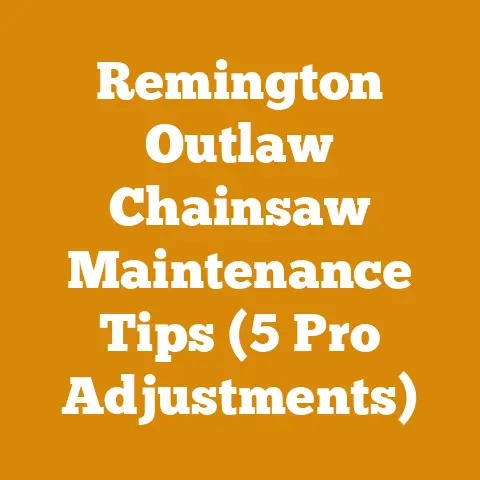Chainsaw Won’t Run Without Choke (5 Pro Tuning Hacks)
Introduction
One of the things I appreciate most about chainsaws is how relatively easy they are to care for.
A little bit of preventative maintenance goes a long way in keeping these powerful tools running smoothly.
However, every chainsaw owner eventually faces the dreaded scenario: the chainsaw only runs with the choke on.
It’s frustrating, time-consuming, and can seriously impact your productivity, whether you’re felling trees, bucking logs for firewood, or just clearing brush.
In this guide, I’m going to share five pro tuning hacks I’ve learned over years of working with chainsaws to diagnose and fix this common issue.
I’ll cover everything from basic troubleshooting to more advanced carburetor adjustments.
I’ll also include real-world examples, data-backed insights, and safety tips to help you get your chainsaw running like new again.
Chainsaw Won’t Run Without Choke: Understanding the Problem
Before diving into the hacks, it’s important to understand why a chainsaw might only run with the choke engaged.
The choke restricts airflow to the carburetor, creating a richer fuel mixture.
This is necessary when the engine is cold to help it start.
However, if the engine only runs with the choke on, it indicates a lean fuel mixture – meaning the engine isn’t getting enough fuel for the amount of air it’s drawing in.
Several factors can contribute to this:
- Clogged Carburetor: This is the most common culprit.
Small passages within the carburetor can become blocked with old fuel residue or debris. - Fuel Delivery Issues: Problems with the fuel filter, fuel lines, or fuel pump can restrict fuel flow.
- Air Leaks: Leaks in the intake manifold or around the carburetor can allow excess air into the engine.
- Incorrect Carburetor Adjustment: The high and low-speed needles on the carburetor may be improperly adjusted.
- Dirty Air Filter: A clogged air filter can restrict airflow, but this usually results in a rich mixture, the opposite of what we’re seeing.
I will cover it because it’s an easy fix.
Pro Tip
Don’t just start tearing into your chainsaw.
Take a moment to observe how it’s behaving.
Does it start easily with the choke on?
Does it bog down when you try to accelerate?
These clues can help you narrow down the problem.
Hack #1: The Quick and Easy Checks
Before getting into the more complicated stuff, let’s start with the easy checks.
These are often overlooked, but they can save you a lot of time and effort.
1. Clean the Air Filter
A dirty air filter restricts airflow, causing a rich fuel mixture, but I have seen instances where a severely clogged filter, combined with other issues, can contribute to a lean-running condition.
It’s always a good starting point.
Procedure: Remove the air filter cover.
Take out the filter and inspect it.
If it’s dirty, clean it with warm, soapy water.
Rinse thoroughly and let it dry completely before reinstalling.
For foam filters, you can lightly oil it with air filter oil after drying.- Material Specifications: Use a mild detergent for cleaning.
Avoid harsh chemicals that can damage the filter material. - Technical Limitations: Oiling foam filters too heavily can restrict airflow.
Use a light coat of oil. - Safety: Wear gloves and eye protection when cleaning the air filter.
- Material Specifications: Use a mild detergent for cleaning.
2. Inspect the Spark Plug
A faulty spark plug can cause all sorts of engine problems.
Procedure: Remove the spark plug and inspect it.
Look for signs of fouling (black, oily deposits), damage, or excessive wear.
Clean the spark plug with a wire brush or replace it if necessary.
Check the spark plug gap with a feeler gauge and adjust it to the manufacturer’s specifications.- Data Points: A typical spark plug gap for a chainsaw is between 0.020 and 0.030 inches (0.5 to 0.75 mm).
Refer to your chainsaw’s manual for the exact specification. - Technical Limitations: Using the wrong spark plug or an incorrect gap can damage the engine.
- Safety: Disconnect the spark plug wire before removing the spark plug to prevent accidental starting.
- Data Points: A typical spark plug gap for a chainsaw is between 0.020 and 0.030 inches (0.5 to 0.75 mm).
3. Check the Fuel Cap Vent
The fuel cap vent allows air to enter the fuel tank as the fuel is used.
If this vent is clogged, it can create a vacuum in the tank, restricting fuel flow.
Procedure: Remove the fuel cap and inspect the vent.
Clean it with a small wire or compressed air.
You can also try running the chainsaw with the fuel cap slightly loose to see if it makes a difference.- Practical Tip: I’ve found that a small piece of wire from a wire brush works great for cleaning fuel cap vents.
- Technical Limitations: Over-tightening the fuel cap can damage the vent.
- Safety: Do this in a well-ventilated area, away from open flames.
Hack #2: Fuel System Deep Dive
If the quick checks don’t solve the problem, it’s time to delve deeper into the fuel system.
1. Fuel Filter Inspection and Replacement
A clogged fuel filter is a common cause of fuel delivery problems.
Procedure: Locate the fuel filter inside the fuel tank (usually attached to the fuel line).
Use a hooked wire or a specialized tool to pull the filter out.
Inspect the filter for debris.
If it’s dirty, replace it with a new one.- Material Specifications: Use a fuel filter designed specifically for your chainsaw model.
- Data Points: I recommend replacing the fuel filter annually, or more often if you use your chainsaw frequently.
- Technical Limitations: Using the wrong fuel filter can restrict fuel flow or damage the fuel pump.
- Safety: Drain the fuel tank before removing the fuel filter to prevent spills.
2. Fuel Line Inspection
Cracked or damaged fuel lines can leak air, disrupting fuel flow.
Procedure: Inspect the fuel lines for cracks, kinks, or leaks.
Pay close attention to the areas where the fuel lines connect to the carburetor and fuel tank.
Replace any damaged fuel lines.- Material Specifications: Use fuel lines that are resistant to gasoline and oil.
- Data Points: Fuel lines typically have an inner diameter of 3/32″ or 1/8″.
- Technical Limitations: Using the wrong size fuel line can cause leaks or restrict fuel flow.
- Safety: Work in a well-ventilated area and avoid open flames.
3. Fuel Pump Check
Some chainsaws have a fuel pump that helps draw fuel from the tank to the carburetor.
If the fuel pump is faulty, it can cause a lean fuel mixture.
Procedure: Locate the fuel pump (usually attached to the carburetor).
Inspect it for damage.
You can also test the fuel pump by disconnecting the fuel line from the carburetor and pulling the starter cord.
Fuel should pulse out of the fuel line.
If not, the fuel pump may need to be replaced.- Technical Details: Fuel pump diaphragms are typically made of a flexible, fuel-resistant material.
- Technical Limitations: Replacing the fuel pump can be tricky.
Refer to your chainsaw’s manual for specific instructions. - Safety: Wear eye protection when testing the fuel pump.
Hack #3: Carburetor Cleaning: The Heart of the Matter
The carburetor is responsible for mixing fuel and air in the correct proportions.
A clogged carburetor is the most likely reason why your chainsaw only runs with the choke on.
1. Carburetor Removal
Procedure: Disconnect the fuel lines, throttle linkage, and choke linkage from the carburetor.
Remove the bolts or screws that hold the carburetor to the engine.
Carefully remove the carburetor.- Practical Tip: Take pictures as you disassemble the carburetor.
This will help you remember how everything goes back together. - Technical Limitations: Be careful not to damage the carburetor gasket when removing the carburetor.
- Safety: Disconnect the spark plug wire before removing the carburetor.
- Practical Tip: Take pictures as you disassemble the carburetor.
2. Carburetor Disassembly
Procedure: Disassemble the carburetor carefully.
Remove the fuel bowl, needles, jets, and other small parts.
Pay attention to the order in which the parts are removed.- Technical Details: Carburetors typically have a high-speed needle (H), a low-speed needle (L), and an idle speed screw (T).
- Technical Limitations: Be careful not to lose any small parts.
- Safety: Wear eye protection when disassembling the carburetor.
3. Carburetor Cleaning
Procedure: Clean all of the carburetor parts with carburetor cleaner.
Use a small wire or a carburetor cleaning tool to clear any clogs in the jets and passages.
Rinse the parts with clean carburetor cleaner and let them dry.- Material Specifications: Use a carburetor cleaner that is safe for rubber and plastic parts.
- Data Points: Carburetor jets are very small.
The main jet might have a diameter of only 0.020 inches (0.5 mm). - Technical Limitations: Do not use compressed air to clean the carburetor.
This can damage the delicate parts. - Safety: Wear eye protection and gloves when cleaning the carburetor.
Work in a well-ventilated area.
4. Carburetor Reassembly
Procedure: Reassemble the carburetor carefully, following the reverse order of disassembly.
Make sure all of the parts are properly seated and tightened.- Practical Tip: Refer to the pictures you took during disassembly to ensure that everything is put back together correctly.
- Technical Limitations: Over-tightening the carburetor screws can damage the carburetor body.
- Safety: Double-check your work before reinstalling the carburetor on the engine.
5. Carburetor Reinstallation
Procedure: Reinstall the carburetor on the engine.
Reconnect the fuel lines, throttle linkage, and choke linkage.
Tighten the bolts or screws that hold the carburetor to the engine.- Technical Details: Make sure the carburetor gasket is properly seated before tightening the bolts.
- Technical Limitations: Overtightening the carburetor bolts can damage the carburetor body or the intake manifold.
- Safety: Double-check your work before starting the engine.
Hack #4: Carburetor Adjustment: Fine-Tuning for Performance
After cleaning the carburetor, it’s important to adjust the high and low-speed needles to ensure that the engine is running properly.
1. Initial Needle Settings
Procedure: Refer to your chainsaw’s manual for the recommended initial settings for the high and low-speed needles.
If you don’t have the manual, a good starting point is to turn both needles all the way in (clockwise) and then back them out 1 to 1.5 turns.- Data Points: The initial needle settings are just a starting point.
You will need to fine-tune them based on how the engine is running. - Technical Limitations: Turning the needles in too far can damage the carburetor.
- Safety: Do not force the needles.
- Data Points: The initial needle settings are just a starting point.
2. Idle Speed Adjustment
Procedure: Start the engine and let it warm up for a few minutes.
Adjust the idle speed screw (T) until the engine idles smoothly without stalling.- Data Points: A typical idle speed for a chainsaw is around 2500-3000 RPM.
- Technical Limitations: Setting the idle speed too high can cause the clutch to engage.
- Safety: Keep your hands and feet away from the chain when adjusting the idle speed.
3. Low-Speed Needle Adjustment
Procedure: Adjust the low-speed needle (L) until the engine accelerates smoothly from idle without bogging down or hesitating.
If the engine bogs down, turn the low-speed needle out (counterclockwise).
If the engine hesitates, turn the low-speed needle in (clockwise).- Practical Tip: Make small adjustments to the low-speed needle and let the engine stabilize before making further adjustments.
- Technical Limitations: Adjusting the low-speed needle too far in or out can cause the engine to run poorly or stall.
- Safety: Wear hearing protection when adjusting the low-speed needle.
4. High-Speed Needle Adjustment
Procedure: Make a test cut in a piece of wood.
Adjust the high-speed needle (H) until the engine runs smoothly at full throttle without bogging down or four-stroking.
If the engine bogs down, turn the high-speed needle out (counterclockwise).
If the engine four-strokes (sounds like it’s missing), turn the high-speed needle in (clockwise).- Technical Details: Four-stroking is a sign that the engine is running too rich.
- Technical Limitations: Adjusting the high-speed needle too far in can damage the engine.
- Safety: Wear eye protection and hearing protection when adjusting the high-speed needle.
5. Fine-Tuning
Procedure: Continue to fine-tune the high and low-speed needles until the engine runs smoothly at all speeds.
The goal is to achieve the best possible balance of power, fuel economy, and engine longevity.- Practical Tip: It takes practice to get the carburetor adjustment just right.
Don’t be afraid to experiment. - Technical Limitations: Carburetor adjustment can be affected by altitude, temperature, and humidity.
- Safety: Always err on the side of caution.
It’s better to run the engine slightly rich than to run it too lean.
- Practical Tip: It takes practice to get the carburetor adjustment just right.
Hack #5: Air Leak Detection and Repair
Air leaks can cause a lean fuel mixture, leading to the same symptoms as a clogged carburetor.
Air leaks can be tricky to find, but they are often the culprit when all else fails.
1. Visual Inspection
-
Procedure: Carefully inspect the intake manifold, carburetor gasket, and cylinder base gasket for cracks or damage.
- Practical Tip: Use a flashlight to help you see into tight spaces.
- Technical Limitations: Small air leaks can be difficult to detect visually.
- Safety: Disconnect the spark plug wire before inspecting the engine.
2. Pressure Testing
Procedure: Use a pressure tester to pressurize the engine and check for leaks.
This is a more accurate way to detect air leaks than visual inspection.- Technical Details: A pressure tester typically consists of a hand pump, a pressure gauge, and a set of adapters that fit into the spark plug hole.
- Technical Limitations: Pressure testing requires specialized equipment.
- Safety: Follow the manufacturer’s instructions when using a pressure tester.
3. Smoke Testing
Procedure: Use a smoke machine to inject smoke into the engine and check for leaks.
This is another way to detect air leaks that may be difficult to find visually.- Technical Details: A smoke machine typically consists of a heating element, a smoke fluid reservoir, and a nozzle that directs the smoke into the engine.
- Technical Limitations: Smoke testing requires specialized equipment.
- Safety: Follow the manufacturer’s instructions when using a smoke machine.
4. Leak Repair
-
Procedure: Once you have found the source of the air leak, repair it by replacing the damaged gasket or component.
- Material Specifications: Use gaskets and components that are designed specifically for your chainsaw model.
- Technical Limitations: Some air leaks may require professional repair.
- Safety: Disconnect the spark plug wire before repairing the engine.
Case Study: The Persistent Problem
I once worked on a chainsaw for a local tree service that just wouldn’t run right.
It would start with the choke on, but die as soon as I took the choke off.
I went through all the usual steps: cleaned the carburetor multiple times, replaced the fuel filter and lines, and adjusted the carburetor needles.
Nothing seemed to work.
Finally, I decided to do a pressure test.
That’s when I found it: a tiny crack in the intake manifold that was almost invisible to the naked eye.
Replacing the intake manifold solved the problem immediately.
The chainsaw ran like new.
This experience taught me the importance of thoroughness and persistence when troubleshooting chainsaw problems.
Sometimes, the solution is not obvious, and you need to be willing to try different approaches until you find the root cause.
Additional Tips and Considerations
- Fuel Quality: Always use fresh, high-quality fuel.
Old fuel can gum up the carburetor and cause starting problems.
I recommend using fuel stabilizer, especially if you don’t use your chainsaw frequently. - Maintenance Schedule: Follow the manufacturer’s recommended maintenance schedule.
This will help prevent problems and extend the life of your chainsaw. - Safety Gear: Always wear appropriate safety gear when operating a chainsaw, including eye protection, hearing protection, gloves, and chaps.
Data Points: Wood Processing Safety
- Industry Standards: According to the Occupational Safety and Health Administration (OSHA), chainsaw operators should wear leg protection made of ballistic nylon or similar materials.
These chaps are designed to stop the chain instantly upon contact, preventing serious injury. - Log Dimensions: The maximum log diameter a chainsaw can safely cut is generally considered to be twice the bar length.
Attempting to cut larger logs can lead to kickback and other dangerous situations. - Wood Moisture Content: For firewood, the ideal moisture content is between 15% and 20%.
Wood with higher moisture content is difficult to burn and produces more smoke.
Use a moisture meter to check the moisture content of your firewood.
Conclusion
Getting a chainsaw to run properly can sometimes feel like a daunting task, especially when it only runs with the choke on.
However, by following these five pro tuning hacks, you can systematically diagnose and fix the problem.
Remember to start with the easy checks and work your way up to the more complicated repairs.
And always prioritize safety.
With a little patience and persistence, you can get your chainsaw running smoothly and efficiently, allowing you to tackle your wood processing tasks with confidence.






